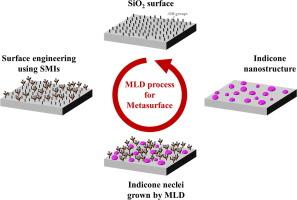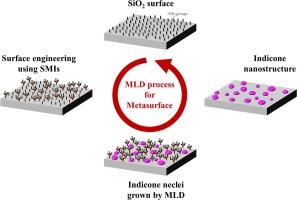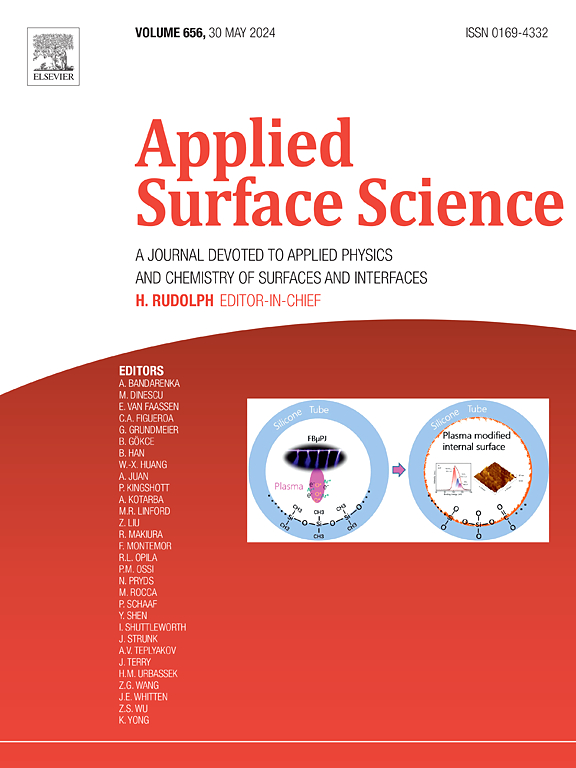先进的指示剂纳米结构:通过分子层沉积使用小分子抑制剂的表面工程
IF 6.9
2区 材料科学
Q2 CHEMISTRY, PHYSICAL
引用次数: 0
摘要
我们的研究介绍了一种利用茚酮的新型表面工程技术形成透明纳米结构表面的新方法,茚酮是一种很有前途的有机-无机杂化材料,在下一代光学应用中具有很大的潜力。通过在 MLD 工艺中将铟金属有机前驱体与氯代葡萄糖醇相结合,我们获得了在可见光谱中具有约 70% 透光率和 1.7-2.0 折射率的茚酮层,使其成为先进超表面应用的理想材料。为了有效控制表面成核并提高纳米结构的清晰度,我们采用了 N,N-二甲基三甲基硅胺(DMA-TMS)作为小分子抑制剂(SMI)。抑制剂的化学适应性、减少的立体阻碍和高表面覆盖率使茚三酮纳米结构在 16 次 MLD 循环后得到了可控生长,实现了具有微调形态的透明表面。此外,原子力显微镜(AFM)可直接观察到 Z 高度和形貌的纳米级变化,突出显示了通过 DMA-TMS 调节实现的成功控制。没有经过 SMI 处理的表面显示出快速成核和光滑度,强调了我们的方法在形成纳米级特征方面的影响。这些发现强调了我们的表面工程技术在创建透明的纳米结构籼米表面方面的有效性,而原子力显微镜分析则在验证形态控制方面发挥了关键作用。这种方法推动了纳米制造技术的发展,支持将茚酮集成到各种下一代光学应用中。本文章由计算机程序翻译,如有差异,请以英文原文为准。


Advanced indicone Nanostructuring: Surface engineering with small molecule inhibitors through molecular layer deposition
Our study introduces a novel approach to forming transparent nanostructured surfaces using novel surface engineering technique of indicone, a promising organic–inorganic hybrid material with high potential for next-generation optical applications. By combining an indium metal–organic precursor with phloroglucinol in the MLD process, we achieved indicone layers that exhibit approximately 70% transmittance in the visible spectrum and a refractive index of 1.7–2.0, making them ideal for advanced metasurface application. To gain effective control over surface nucleation and enhance nanostructural definition, we employed N,N-Dimethyltrimethylsilylamine (DMA-TMS) as a small molecule inhibitor (SMI). The inhibitor’s chemical adaptability, reduced steric hindrance, and high surface coverage enabled the controlled growth of indicone nanostructures after 16 MLD cycles, achieving a transparent surface with finely tuned morphology. Also, Atomic Force Microscopy (AFM) provided direct visualization of the nanoscale changes in z-height and morphology, highlighting the successful control achieved through DMA-TMS regulation. Surfaces without SMI treatment showed rapid nucleation and smoothness, emphasizing the impact of our approach in forming nanoscale features. These findings underscore the effectiveness of our surface engineering technique for creating transparent, nanostructured indicone surfaces, with AFM analysis playing a pivotal role in verifying morphological control. This method advances nanofabrication techniques, supporting the integration of indicone in a variety of next-generation optical applications.
求助全文
通过发布文献求助,成功后即可免费获取论文全文。
去求助
来源期刊

Applied Surface Science
工程技术-材料科学:膜
CiteScore
12.50
自引率
7.50%
发文量
3393
审稿时长
67 days
期刊介绍:
Applied Surface Science covers topics contributing to a better understanding of surfaces, interfaces, nanostructures and their applications. The journal is concerned with scientific research on the atomic and molecular level of material properties determined with specific surface analytical techniques and/or computational methods, as well as the processing of such structures.
 求助内容:
求助内容: 应助结果提醒方式:
应助结果提醒方式:


